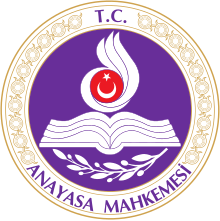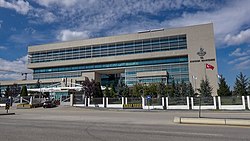Constitutional Court of Turkey
| Constitutional Court | |
|---|---|
| Anayasa Mahkemesi | |
 | |
 Constitutional Court building in Ankara | |
| Established | 1961 |
| Location | , Çankaya, Ankara |
| Coordinates | 39°50′42″N 32°47′22″E / 39.845°N 32.7895°ECoordinates: 39°50′42″N 32°47′22″E / 39.845°N 32.7895°E |
| Motto | "Rights and freedoms are dignity and virtue of humanity" |
| Composition method | Legislative/Executive appointment |
| Authorized by | Constitution of Turkey |
| Appeals to | Final |
| Judge term length | 12 years or until age 65 |
| Number of positions | 15 |
| Website | www |
| President of the Constitutional Court | |
| Currently | Zühtü Arslan |
| Since | 2015 |
| Lead position ends | 4 years (renewable) |
| Vice Presidents of the Constitutional Court | |
| Currently | & |
| Since | 2019 |
| Lead position ends | 4 years (renewable) |
The Constitutional Court of Turkey (Turkish: Anayasa Mahkemesi, sometimes abbreviated as AYM) is the highest legal body for constitutional review in Turkey. It "examines the constitutionality, in respect of both form and substance, of laws, decrees having the force of law, and the Rules of Procedure of the Turkish Grand National Assembly" (Article 148/1 of the Turkish Constitution). If necessary, it also functions as the Supreme Criminal Court (Turkish: Yüce Divan) to hear any cases raised about the President, Vice President, members of the Cabinet, or judges of the high courts. In addition to those functions, it examines individual applications on the grounds that one of the fundamental rights and freedoms within the scope of the European Convention on Human Rights which are guaranteed by the Constitution has been violated by public authorities (Article 148/3 of the Turkish Constitution).
Overview[]
Part Four, Section Two of the Constitution establishes the Constitutional Court that rules on the constitutionality of statutes and Presidential executive orders. The Court rules on issues referred to it by the President, the members of Parliament, or any judge before whom an exception of unconstitutionality has been raised by a defendant or a plaintiff. The Constitutional Court has the right to both a priori and a posteriori review (respectively, before and after enactment), and it can invalidate whole laws or governmental decrees and prevent their application in future cases. Challenges to a law must be made within the first two months of its promulgation.
Organization[]
According to Article 146 of the Constitution, the Constitutional Court is composed of fifteen members.
The President appoints:
- three members from a list of three candidates for each vacant position nominated by the Court of Cassation among its own members,
- two members from a list of three candidates for each vacant position nominated by the Turkish Council of State among its own members,
- three (at least two of whom being lawyers) members from a list of three candidates for each vacant position nominated by the Higher Education Council among professors of law, economy or political sciences, who are themselves not members of the Council, and
- four members among senior administrative officers, attorneys-at-law, judges, prosecutors, and Constitutional Court clerks with at least five years of experience.
The Parliament appoints by secret ballot and with two-thirds majority:
- two members from a list of three candidates for each vacant position nominated by the Court of Accounts (Turkish: Sayıştay) among its own members,
- one member from a list of three candidates for each vacant position nominated by the heads of bar associations among attorneys-at-law.
To qualify for appointments as a member of the Court, professors, senior administrative officers, and attorneys-at-law are required to be over the age of 40 and to have completed their higher education or to have served at least 15 years as teaching staff of institutions of higher education or to have actually worked at least 21 years in public service or to have practiced as a lawyer for at least 21 years.
The Constitutional Court elects a president and vice presidents from among its regular members for a renewable term of four years by secret ballot and by an absolute majority of their members. The members of the Constitutional Court are not allowed to assume other official and private functions, apart from their main functions.
Composition[]
The Constitutional Court consists of 15 members.
| # | Name | Rank | Date appointed | Term end | Selected by quota | Appointed by |
|---|---|---|---|---|---|---|
| 1 | Zühtü Arslan | President | 17 April 2012 | 17 April 2024 | Council of Higher Education | Abdullah Gül |
| 2 | Vice President | 17 March 2014 | 17 March 2026 | Court of Cassation | Abdullah Gül | |
| 3 | Vice President | 18 December 2014 | 18 December 2026 | Council of State | Recep Tayyip Erdoğan | |
| 4 | Engin Yıldırım | Member | 9 April 2010 | 2 April 2022 | Council of Higher Education | Abdullah Gül |
| 5 | Member | 6 October 2010 | 6 October 2022 | Court of Auditors | GNAT | |
| 6 | Member | 13 October 2010 | 31 January 2022 | President of Bar | GNAT | |
| 7 | Member | 29 January 2012 | 29 January 2024 | Council of State | Abdullah Gül | |
| 8 | Member | 8 March 2013 | 12 May 2024 | Executive or Lawyer | Abdullah Gül | |
| 9 | Member | 13 March 2015 | 13 March 2027 | Court of Auditors | GNAT | |
| 10 | Member | 25 August 2016 | 25 August 2028 | Executive or Lawyer | Recep Tayyip Erdoğan | |
| 11 | Member | 25 August 2016 | 25 August 2028 | Council of Higher Education | Recep Tayyip Erdoğan | |
| 12 | Member | 25 January 2019 | 25 January 2031 | Executive or Lawyer | Recep Tayyip Erdoğan | |
| 13 | Member | 5 July 2019 | 5 July 2031 | Executive or Lawyer | Recep Tayyip Erdoğan | |
| 14 | Member | 2 April 2020 | 4 April 2032 | Court of Cassation | Recep Tayyip Erdoğan | |
| 15 | Member | 23 January 2021 | 23 January 2033 | Court of Cassation | Recep Tayyip Erdoğan |
History[]
The Constitutional Court of Turkey was established on April 25, 1962, according to the provisions of the constitution of 1961. Prior to that date, absolute superiority of the parliament was adopted as a constitutional principle, with no judicial review. There existed no legal institution to review the constitutionality of laws passed by the parliament, and of acts and actions of governments. The social democratic opposition, intellectuals, and the military junta that came into power by military coup on May 27, 1960 supported limitation and control of the parliamentary power in the face of abuses of parliamentary majority by the Democratic Party governments (1950–60) under the premiership of Adnan Menderes. The Justice Party, a descendant of the Democratic Party; as well as Justice and Development Party have rejected the idea of judicial review, pushing for parliamentary superiority.
The first decision the court gave is dated September 5, 1962, which was published on the Official Gazette on October 3, 1962. It was about a direct petition by a certain İnaç Tureren for the annulment of an article of the Law of Criminal Procedure (Ceza Muhakemeleri Usûlü Kanunu - CMUK), which was claimed to be violating the provisions of Article 30 of the constitution. The court turned down the case, stating that individual application to the court was constitutionally impossible.[1]
The first president of the court was Sünuhi Arsan, who served for two years (1962–64). Following the second (Ömer Lütfi Akadlı - 1964-66) and the third (İbrahim Senil - 1966-68) presidents, the court failed to elect a president for 29 months (until 1970) during which it was headed by an acting president.
The articles of the constitution regulating the structure of the court were slightly amended in 1971 and 1973.
Although the constitution of 1961 was annulled by the military regime that came into the power with the military coup of September 12, 1980, the court went on operating. It currently operates according to the constitution of 1982.
Key decisions[]
- Decision no. 1989/12, dated 07.03.1989: The Court, in response to then president Kenan Evren's application for annulment of a law passed by parliament, ruled that wearing headscarves in public universities violated the separation of religion and state.
- Decision no. 1994/2, dated 16.06.1994: The Court ruled to close the Democracy Party (Demokrasi Partisi - DEP), a pro-Kurdish party, on the grounds that it violated the principle of territorial/national integrity and indivisibility.
- Decision no. 1998/1, dated 16.01.1998: The Court ruled to close the Welfare Party (Refah Partisi - RP), an Islamist party, on the grounds that it was violating the principle of secularism.
- Decision no. 2001/2, dated 21.06.2001: The Court ruled to close the Virtue Party (Fazilet Partisi - FP), the successor to the Welfare Party. The decision, however, stated that the Court did not consider the FP to be the continuation of the RP, but cited the Islamist policies followed by the party as the main reasons behind the closure.
- Decision no. 2001/332, dated 18.07.2001: The Court, in response to applications made by regular courts, ruled that some parts of the Amnesty Law passed by the parliament were unconstitutional, which resulted in a minor expansion in the scope of the proposed amnesty.
- Decision dated 2008/7/30: In the 2008 Justice and Development Party closure trial, the court ruled that the Justice and Development Party did not violate the separation of religion and state and did not close it, but noted that it had become "a center for anti-secular activities" and cut the state's funding of the party's activities by 50%.[2]
- Decision dated 2009/12/11: The court decided to ban the Democratic Society Party for its links to the Kurdistan Workers Party (PKK), considered a terrorist group by the United States and the European Union. DTP violated Articles 68 and 69 of the Constitution and the Political Parties Law.[3] "The party became a focal point for terrorism against the indivisible integrity of the state.", stated Haşim Kılıç, president of the Court.[3]
- Decision dated 26.12.2019 lifting the ban on Wikipedia[4]
See also[]
- Republic of Turkey
- Legal System in the Republic of Turkey
- Constitution
- Constitutionalism
- Constitutional economics
- Jurisprudence
- Rule of law
- Judiciary
- Rule According to Higher Law
References[]
- ^ Esas No : 1962/2 Archived 2007-09-27 at the Wayback Machine
- ^ Today's Zaman, 19 August 2013, AK Party to ask for retrial by Constitutional Court Archived 2013-08-20 at the Wayback Machine
- ^ Jump up to: a b Turkey's Constitutional Court closes DTP
- ^ Tecimer, Cem: "Why the Turkish Constitutional Court’s Wikipedia Decision is No Reason to Celebrate", Verfassungsblog, 20.01.2020
Further reading[]
- Arik, K. Fikret (1962-07-02). "La Cour constitutionnelle turque". (in French). Persée. 14 (2): 401–412. doi:10.3406/ridc.1962.13364.
External links[]
- Constitutions of Turkey
- Courts in Turkey
- 1961 establishments in Turkey
- Constitutional courts
- Courts and tribunals established in 1961



